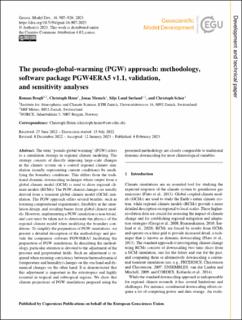| dc.contributor.author | Brogli, Roman | |
| dc.contributor.author | Heim, Christoph | |
| dc.contributor.author | Mensch, Jonas | |
| dc.contributor.author | Sørland, Silje Lund | |
| dc.contributor.author | Schar, Christoph | |
| dc.date.accessioned | 2023-09-01T13:00:15Z | |
| dc.date.available | 2023-09-01T13:00:15Z | |
| dc.date.created | 2023-06-14T13:10:39Z | |
| dc.date.issued | 2023 | |
| dc.identifier.citation | Geoscientific Model Development. 2023, 16 (3), 907-926. | en_US |
| dc.identifier.issn | 1991-959X | |
| dc.identifier.uri | https://hdl.handle.net/11250/3087058 | |
| dc.description.abstract | The term “pseudo-global warming” (PGW) refers to a simulation strategy in regional climate modeling. The strategy consists of directly imposing large-scale changes in the climate system on a control regional climate simulation (usually representing current conditions) by modifying the boundary conditions. This differs from the traditional dynamic downscaling technique where output from a global climate model (GCM) is used to drive regional climate models (RCMs). The PGW climate changes are usually derived from a transient global climate model (GCM) simulation. The PGW approach offers several benefits, such as lowering computational requirements, flexibility in the simulation design, and avoiding biases from global climate models. However, implementing a PGW simulation is non-trivial, and care must be taken not to deteriorate the physics of the regional climate model when modifying the boundary conditions. To simplify the preparation of PGW simulations, we present a detailed description of the methodology and provide the companion software PGW4ERA5 facilitating the preparation of PGW simulations. In describing the methodology, particular attention is devoted to the adjustment of the pressure and geopotential fields. Such an adjustment is required when ensuring consistency between thermodynamical (temperature and humidity) changes on the one hand and dynamical changes on the other hand. It is demonstrated that this adjustment is important in the extratropics and highly essential in tropical and subtropical regions. We show that climate projections of PGW simulations prepared using the presented methodology are closely comparable to traditional dynamic downscaling for most climatological variables. | en_US |
| dc.language.iso | eng | en_US |
| dc.rights | Navngivelse 4.0 Internasjonal | * |
| dc.rights.uri | http://creativecommons.org/licenses/by/4.0/deed.no | * |
| dc.title | The pseudo-global-warming (PGW) approach: Methodology, software package PGW4ERA5 v1.1, validation, and sensitivity analyses | en_US |
| dc.title.alternative | The pseudo-global-warming (PGW) approach: Methodology, software package PGW4ERA5 v1.1, validation, and sensitivity analyses | en_US |
| dc.type | Journal article | en_US |
| dc.type | Peer reviewed | en_US |
| dc.rights.holder | © Author(s) 2023 | en_US |
| dc.description.version | publishedVersion | en_US |
| cristin.ispublished | true | |
| cristin.fulltext | original | |
| cristin.qualitycode | 2 | |
| dc.identifier.doi | 10.5194/gmd-16-907-2023 | |
| dc.identifier.cristin | 2154463 | |
| dc.source.journal | Geoscientific Model Development | en_US |
| dc.source.volume | 16 | en_US |
| dc.source.issue | 3 | en_US |
| dc.source.pagenumber | 907-926 | en_US |

